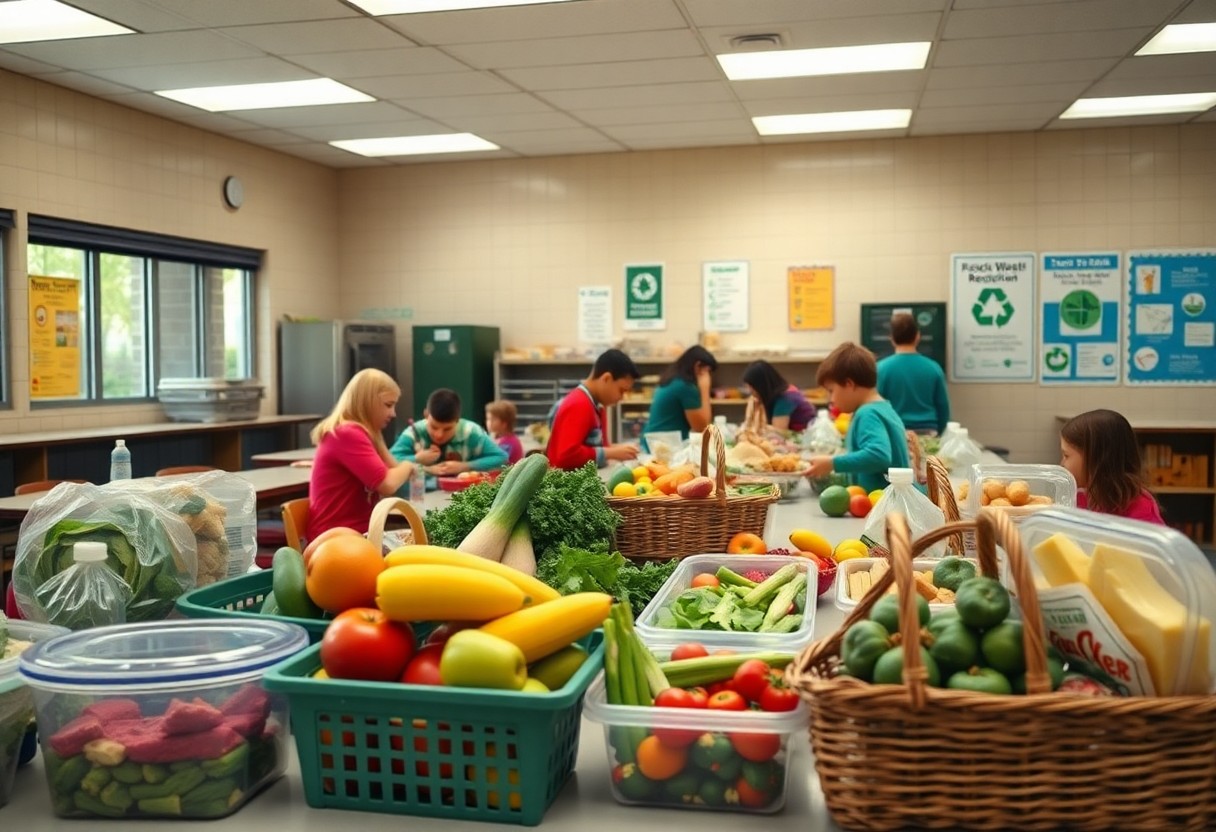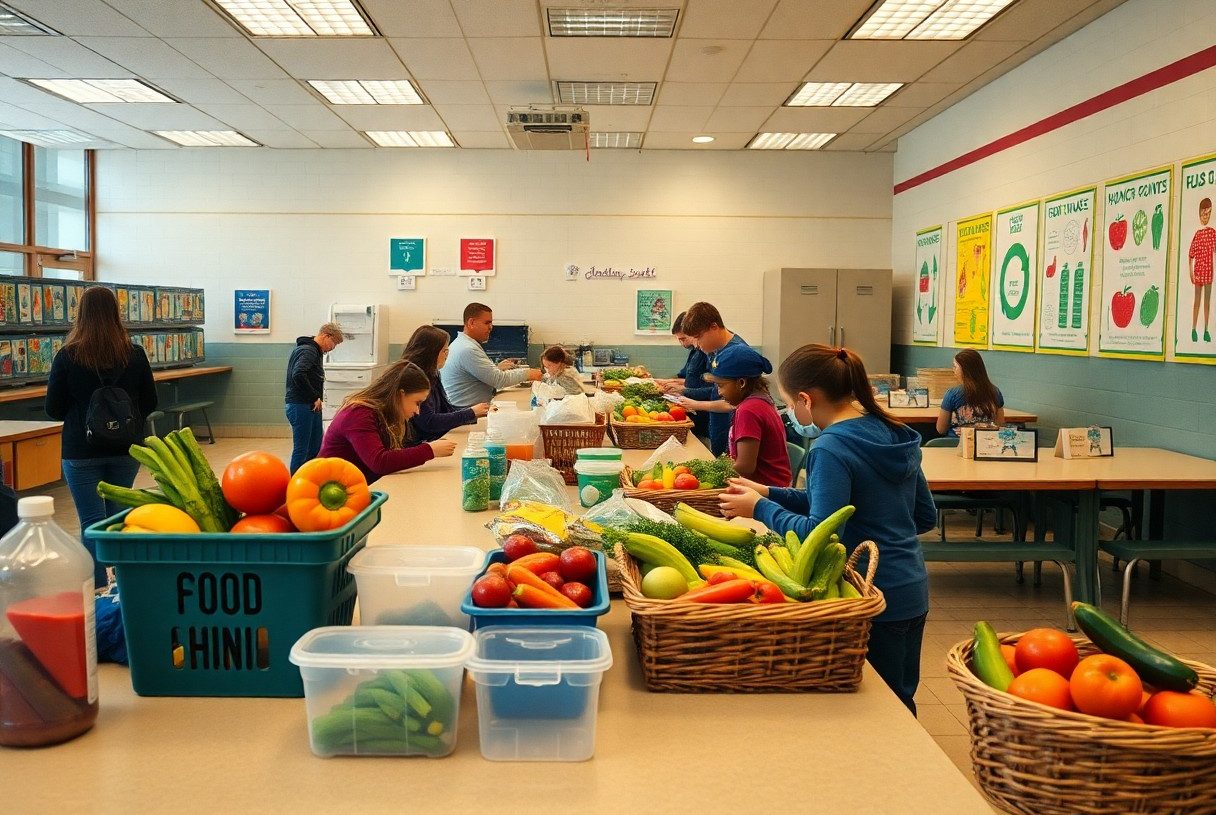Many schools face the challenge of food waste, which not only impacts the environment but also drains valuable resources. You can play a significant role in tackling this issue by understanding effective strategies to minimize waste in your school’s cafeteria and classrooms. From better menu planning to engaging students in sustainability practices, your efforts can lead to a more responsible approach to food consumption. This blog post will explore practical ways you can help reduce food waste in schools, creating a more sustainable future for your community.

Understanding Food Waste in Schools
To effectively tackle food waste in schools, it is necessary to comprehend its scale and implications. Recognizing how much food is wasted and the factors contributing to this issue will empower you to implement strategies that foster sustainability and efficiency within your school’s food service systems. By focusing on waste reduction, you not only benefit the environment but also promote healthier eating habits among students.
Current Statistics
Schools across the nation generate approximately 530,000 tons of food waste each year. This staggering figure highlights the magnitude of the problem and serves as a wake-up call for educational institutions to assess their food service practices. Analyzing these statistics can help you identify areas where change is needed and inspire actionable solutions to minimize waste.
Causes of Food Waste
Across various educational settings, several factors contribute to food waste, including overproduction, improper portion sizes, and a lack of awareness about food preservation. These issues often lead to uneaten meals that end up in the trash rather than being consumed, impacting not only school budgets but also the environment.
Plus, factors such as visual appeal and student preferences also play a significant role in food waste. If meals do not resemble what kids find appetizing, they’re less likely to eat them. Additionally, scheduled lunch times can lead to hurried eating habits, resulting in uneaten food being discarded. Understanding these causes allows you to make informed decisions to enhance food programs and reduce waste effectively.
Strategies for Reducing Food Waste
Assuming you want to create a more sustainable food environment in your school, implementing effective strategies can significantly minimize food waste. Consider approaches that engage students, staff, and the community in fostering a culture of mindful eating and responsibility towards food. By combining education, planning, and clear assessments of food habits, you can create a comprehensive framework aimed at reducing waste and promoting healthier choices in school cafeterias.
Education and Awareness Programs
Any initiative designed to combat food waste must begin with education and awareness programs. By presenting information about the impact of food waste on the environment and economy, you can empower students and staff to make informed choices about their food consumption. Workshops, school assemblies, and engaging activities can illustrate the importance of minimizing waste and promote better habits.
Implementing Waste Audits
For understanding the specific sources of food waste in your school, conducting waste audits can be highly effective. By analyzing what is being discarded, you can identify patterns and develop targeted solutions to address the root causes of waste.
Strategies for implementing waste audits involve systematic collection and analysis of food waste data. This process includes setting specific timelines for audits, creating a designated team to oversee assessments, and documenting the types and amounts of food being thrown away. Once you have this valuable data, you can tailor interventions, such as adjusting portion sizes, improving menu planning, or increasing food recovery efforts, ultimately leading to a more efficient and sustainable food system in your school.

Menu Planning and Portion Control
Even with the best intentions, food waste in schools can occur if menu planning and portion control are not effectively implemented. By carefully designing menus that cater to students’ preferences and nutritional requirements, you can minimize excess food production and encourage consumption. Furthermore, effective portion control ensures that students receive appropriate serving sizes, reducing waste and promoting healthy eating habits.
Designing Balanced Menus
Designing balanced menus involves understanding your students’ dietary needs and preferences to create meals that are both appealing and nutritious. Incorporating a variety of fruits, vegetables, whole grains, and protein sources not only meets nutritional guidelines but also keeps your students engaged and less likely to waste food. By actively involving students in menu selection through surveys or focus groups, you can align offerings with their tastes, enhancing the likelihood of full plates and minimal waste.
Adjusting Portion Sizes
The adjustment of portion sizes is vital to prevent food waste in school cafeterias. By evaluating the consumption patterns and feedback from students, you can identify the optimal serving sizes that satisfy hunger without overwhelming plates. This not only helps to reduce leftover food but also encourages students to enjoy their meals fully.
Understanding the importance of portion sizes is vital in crafting an effective approach to food waste reduction. By analyzing which items are frequently left uneaten, you can tailor the portions accordingly. Utilizing tools like serving cups and portion scales can also help ensure consistency. Engaging students in discussions about appropriate serving sizes creates awareness about food waste, making them more mindful eaters. Through these considerate adjustments, you can foster a culture of respect for food within your school.
Engaging Students in Sustainability
All students play an crucial role in fostering a culture of sustainability within schools. By involving them in initiatives that promote environmentally-friendly practices, you can cultivate a sense of responsibility and pride in reducing food waste. Encouraging student participation not only empowers them but also generates innovative ideas and solutions that can make a significant impact on your school community.
Student-Led Initiatives
Below are several ways your students can take charge of food waste reduction initiatives. By organizing campaigns, starting composting clubs, or creating awareness through creative art or performances, they can actively contribute to fostering a culture of sustainability in your school while developing valuable leadership skills.
Incorporating Food Waste into Curriculum
Food waste can be seamlessly integrated into your curriculum, enhancing students’ understanding of sustainability. Lessons can focus on the environmental impact of waste, effective recycling practices, and innovative cooking techniques that minimize leftover food. This empowers students to apply what they learn and take action in their daily lives.
A hands-on approach to incorporating food waste into your curriculum can include projects like tracking food waste in the cafeteria or developing recipes that creatively use leftovers. By engaging students in real-world issues, you help them connect classroom lessons to daily practices, fostering critical thinking and inspiring them to become active participants in sustainability efforts.
Collaboration with Stakeholders
For effective reduction of food waste in schools, collaboration with stakeholders is necessary. Engaging various parties, including parents, local organizations, and school staff, can foster a community-wide initiative that promotes efficient food use and sustainability. When everyone plays a role, it becomes easier to implement practices that address food waste and encourage mindful consumption among students.
Involving Parents and Community
Against popular belief, parents play a vital role in reducing food waste in schools. By encouraging them to discuss food choices at home, you can create awareness of portion sizes and promote the importance of eating leftovers. Workshops or information sessions can serve as a platform for parents to share their experiences, fostering a community approach to solving food waste challenges.
Partnering with Local Organizations
Any collaboration with local organizations can significantly enhance your food waste reduction efforts. Schools can work with food banks, farms, and sustainability groups to implement effective strategies for managing excess food and educating students about responsible consumption practices.
Also, establishing partnerships with local organizations can facilitate initiatives like food recovery programs and educational workshops. By connecting with local farms, you can arrange for surplus food to be donated or repurposed. Collaborating with food banks could help your school redirect excess food to those in need, showcasing the broader impact of reducing waste. Additionally, involving sustainability-focused organizations can provide valuable resources, such as training sessions for staff and materials for student education, helping to instill lasting, environmentally conscious habits.
Monitoring and Evaluation
Once again, effective monitoring and evaluation are necessary for reducing food waste in schools. By regularly assessing your current practices and tracking the progress of your initiatives, you can identify areas for improvement and ensure that your efforts lead to meaningful change. Establishing clear benchmarks and regularly reviewing your results will enable you to adjust strategies as necessary, fostering an environment of accountability within your school community.
Tracking Food Waste Reduction
Below are some effective methods to track food waste reduction in your school. Implementing waste audits at regular intervals can provide you with insightful data on how much food is being wasted. Additionally, leveraging digital platforms to record and analyze waste trends will help you make informed decisions. By keeping an accurate account of your progress, you can demonstrate the impact of your efforts and engage the community in the journey toward sustainability.
Continuous Improvement Efforts
Reduction is not a one-time effort; it requires ongoing commitment to improve your food waste management practices. You should continuously seek feedback from students and staff regarding what works and what doesn’t. Involving everyone in developing new ideas and solutions fosters a collective sense of responsibility and encourages active participation. By maintaining an adaptive approach, you will enhance not only the effectiveness of your waste reduction initiatives but also cultivate a culture of environmental stewardship within your school.
Waste reduction efforts should be seen as a dynamic process that evolves based on feedback and results. Regular experiments, such as introducing new meal options or portion sizes, allow you to assess which strategies yield the best outcomes. Engaging students in discussions about food waste can provide fresh perspectives and encourage ownership of the initiative. You can also collaborate with local businesses or organizations to share best practices, thereby enhancing your school’s food waste reduction program continuously. By emphasizing a culture of continuous improvement, you are empowering your community to be proactive about sustainability.
Final Words
Ultimately, you can play a significant role in reducing food waste in schools by implementing practical strategies such as organizing food drives, creating compost programs, and educating peers about responsible consumption. By encouraging portion control and introducing more flexible meal options, you can ensure that food preferences are respected, leading to less waste. Collaborating with local farms and businesses to source food can further enhance sustainability. When you take these actions, not only do you contribute to a more sustainable school environment, but you also foster a culture of mindfulness around food usage in your community.
